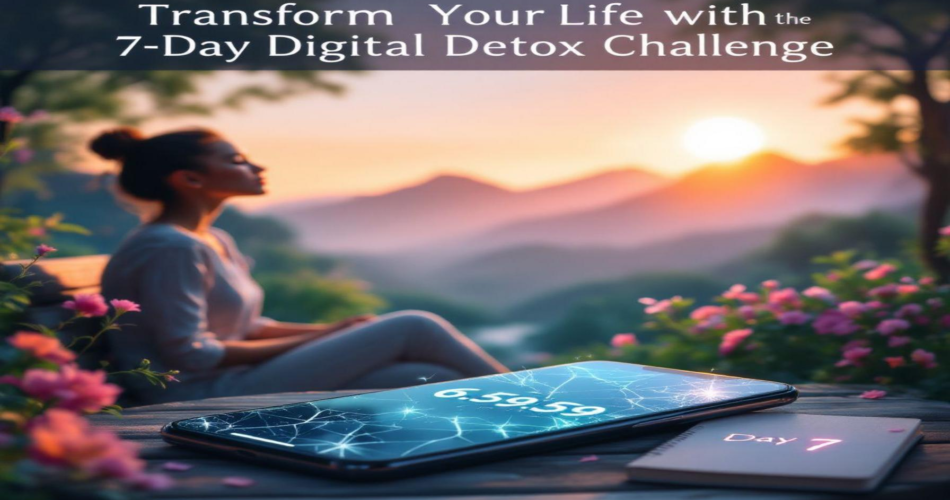Did you know the average adult spends over 7 hours a day looking at screens? From scrolling through social media to answering emails and binge-watching shows, our lives have become increasingly intertwined with the digital world. While technology offers convenience, it’s also a major source of stress, distraction, and sleepless nights. If you’ve felt overwhelmed or disconnected because of screen time, a change might be exactly what you need. Enter the 7-day digital detox challenge—a week-long reset to help you reclaim your time, improve your focus, and reconnect with what really matters.
This challenge isn’t about giving up technology for good; it’s about building healthier habits and regaining control of your digital life. Over the next seven days, we’ll guide you through practical, achievable steps to reduce digital overwhelm and live more intentionally. Let’s dive in and discover how you can reboot your mind and body!
Table of Contents
- Day 1: Assessing Your Digital Habits
- Day 2: Setting Boundaries with Technology
- Day 3: Replacing Screen Time with Healthy Alternatives
- Day 4-6: Building Long-Term Digital Wellness Habits
- Day 7: Reflecting and Moving Forward
- FAQs
- Conclusion
Day 1: Assessing Your Digital Habits
The first step in your 7-day digital detox challenge is understanding how and why you use technology. Awareness is the foundation of meaningful change.
Why You Need to Track Your Screentime
Use apps like Screen Time (iOS) or Digital Wellbeing (Android) to monitor your daily usage. These tools can reveal how many hours you spend on your phone and which apps dominate your time. Pay attention to patterns—are you scrolling out of boredom or habit?
Journaling Your Habits
Spend the day noting when and why you pick up your devices. Are you reacting to notifications, or using screens as a way to avoid something? Identifying triggers is crucial for tackling the root cause of digital dependency.
Day 2: Setting Boundaries with Technology
With your digital habits assessed, it’s time to set clear boundaries to reduce unnecessary screen time.
Establish ‘No-Tech Zones’
Create areas in your home where technology is off-limits. For example, make your bedroom a sanctuary for rest and relaxation, free of phones or laptops. Similarly, designate family mealtimes as device-free to encourage deeper conversations.
The Power of Notifications Control
Turn off non-essential notifications to limit interruptions. Instead of reacting to constant pings, check emails and messages at scheduled intervals. This simple shift can significantly boost your focus and productivity.
Day 3: Replacing Screen Time with Healthy Alternatives
Reducing screen time doesn’t have to feel like a sacrifice. Replace it with fulfilling, offline activities.
Engaging in Offline Hobbies
Start a new project that doesn’t involve technology. Try activities like painting, gardening, or journaling. Physical hobbies like yoga or hiking are also great for boosting mental health and helping you reconnect with nature.
Connecting with Others in Real Life
Plan quality time with friends or family, whether it’s a coffee date, game night, or a shared outdoor adventure. Focus on building meaningful connections rather than scrolling through updates.
Day 4-6: Building Long-Term Digital Wellness Habits
By now, you’re building momentum. Days 4 through 6 are all about solidifying habits that promote a healthier relationship with technology.
Prioritize Mindfulness Practices
Mindfulness techniques, like meditation and deep breathing, can help you be present in the moment without reaching for your phone. Journaling is another way to reflect and fill idle time positively.
Use Technology Intentionally
Switch to apps that enhance productivity and discourage mindless scrolling. Examples include focus-tracking tools or educational apps. Set a purpose every time you log on to ensure your screen time adds value to your life.
Day 7: Reflecting and Moving Forward
Congratulations! You’ve reached the final day of the 7-day digital detox challenge. Now it’s time to reflect and plan ahead.
Evaluating the Detox Experience
Think about the past week—what changes were the most impactful? Were there moments when you felt tempted to break the detox? Reflecting allows you to identify both challenges and successes.
Creating an Ongoing Digital Wellness Plan
Set long-term goals for managing your tech use. For instance, you could schedule regular mini-detoxes (like one screen-free day per week) to maintain the benefits you’ve gained.
Frequently Asked Questions
What is a 7-day digital detox challenge, and why is it important?
The challenge involves temporarily reducing or eliminating non-essential screen usage to reset your habits, reduce mental clutter, and live more intentionally.
What are the benefits of a digital detox?
Benefits include improved focus, deeper sleep, stronger connections with others, and reduced stress from constant notifications and screen fatigue.
How can I stick to a digital detox in a busy work environment?
Set clear boundaries, such as dedicated work hours for screen use and ‘no-tech zones’ for personal time. Prioritize non-urgent tasks offline whenever possible.
How often should I do a digital detox?
While it depends on your lifestyle, consider a 7-day detox every three to six months. Mini-detoxes, such as screen-free evenings or weekends, can also help maintain balance.
Can I use my phone for essential tasks during the detox?
Yes! The goal is not deprivation but intentionality. Use technology for work, communication, or navigation as needed—just avoid mindless scrolling.
Conclusion
Embarking on the 7-day digital detox challenge is a bold step toward reclaiming your time and focus in a tech-driven world. By assessing your habits, setting boundaries, and embracing offline alternatives, you can enjoy the transformative benefits of balanced digital use.
The path to a healthier tech relationship starts with small, intentional changes—are you ready to make them? Start your detox today and take back control of your digital life. The road to clarity and connection is just one week away.


